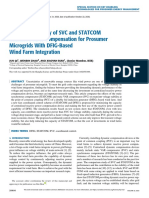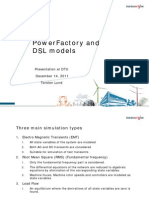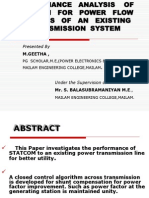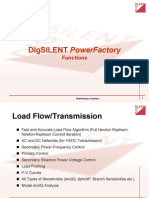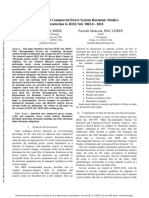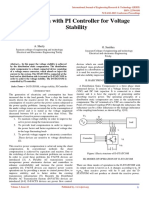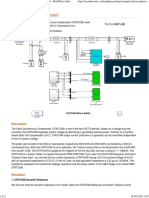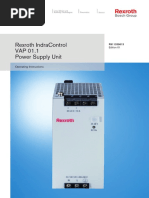Modeling and Simulation of A Distribution STATCOM
Uploaded by
Anonymous i8hifn7Modeling and Simulation of A Distribution STATCOM
Uploaded by
Anonymous i8hifn7IECONOl: The 27th Annual Conference of the IEEE Industrial Electronics Society
Modeling and Simulation of a Distribution STATCOM
using Sirnulink’s Power System Blockset
Pierre Giroux’ Gilbert Sybille’ Hoang Le-Huy2
* Laboratoire Simulation de reseaux Dept. of Electrical and Computer Engineering
Institut de recherche d’Hydro-Quebec (IREQ) UniversitC Lava1
Varennes, QC, Canada QuCbec, QC, Canada
giroux.pierre@ireq.ca, sybille.gilbert@ireq.ca lehuy@gel. ulaval.ca
Abstract - This paper presents a study on the modeling of a STAT- 11. DESCRIPTION OF THE D-STATCOM OPERATION
COM (Static Synchronous Compensator) used for reactive power
compensation on a distribution network. The power circuits of the In distribution networks, the STATCOM (Static Synchro-
D-STATCOM and the distribution network are modeled by spe-
nous Compensator) is a shunt device that regulates the system
cific blocks from the Power System Blockset while the control sys-
tem is modeled by Simulink blocks. Static and dynamic voltage by absorbing or generating reactive power.
performance of a E3 Mvar D-STATCOM on a 25-kV network is Fig. 1 shows a simplified diagram of a STATCOM con-
evaluated. An “average modeling” approach is proposed to sim- nected to a typical distribution network represented by an
plify the PWM inverter operation and to accelerate the simulation equivalent network.
for control parameters adjusting purpose. Simulation perfor-
mance obtained with both modeling approaches are presented
and compared. 25 kV
100 MVA Feeder
-
I. INTRODUCTION
6”
4
PWM Inverter
Electricity suppliers are. nowadays concerned about the
quality of the power delivered to customers. With the develop-
ments of power electronics, several solutions have been pro-
posed to compensate for the fluctuations observed on the
distribution networks in order to ensure highest possible power
Fig. 1 Simplified diagram of a D-STATCOM connected to
quality for the customers [ 2 ] .
a distribution network.
These “Power Quality Devices” (PQ Devices) are power
electronic converters connected in parallel or in series with the
lines and the operation is controlled by a digital controller [ 13, The STATCOM consists mainly of a PWM inverter con-
[ 2 ] , [3], [4]. The interaction between the PQ device and the nected to the network through a transformer. The dc link volt-
network is preferably studied by simulation. The modeling of age is provided by capacitor C which is charged with power
these complex systems that contain both power circuits and taken from the network. The control system ensures the regula-
control systems can be done on different bases, depending on tion of the bus voltage and the dc link voltage.
the trade-offs that we are ready to accept and on the degree of The D-STATCOM function is to regulate the bus voltage by
accuracy of what we want to study (switching in power con- absorbing or generating reactive power to the network, like a
verter or controller tuning). The modeling abstraction degree in thyristor static compensator. This reactive power transfer is
these systems can be thus adapted to the study requirements. done through the leakage reactance of the coupling transformer
In this paper, two approaches to model a distribution STAT- by using a secondary voltage in phase with the primary voltage
COM (Static Synchronous Compensator) are considered and (network side). This voltage is provided by a voltage-source
evaluated, that is “device modeling” and “average modeling”. PWM inverter. The D-STATCOM operation is illustrated by
Both modeling approaches take advantage of Simulink and the phasor diagrams shown in Fig. 2. When the secondary volt-
Power System Blockset to implement in the same diagram the age (V,) is lower than the bus voltage (VB), the D-STATCOM
power circuit and control system. The models are described acts like an inductance absorbing reactive power from the bus.
and the simulation results are presented. They will be then When the secondary voltage (V,) is higher than the bus volt-
compared. age (VB), the D-STATCOM acts like a capacitor generating
reactive power to the bus. In steady state, due to inverter losses
the bus voltage always leads the inverter voltage by a small
angle to supply a small active power.
0-7803-7108-9/01/$10.00(C)2001 IEEE 990
IECON’OI: The 27th Annual Conference of the IEEE Industrial Electronics Society
Blockset [SI and control blocks from Simulink library. We con-
sider here a +3Mvar D-STATCOM connected to a 25-kV distri-
bution network.
Figure 3 shows a Simulink diagram which represents the D-
STATCOM and the distribution network.
The feeding network is represented by a Thevenin equiva-
lent (bus B l ) followed by a 21-km feeder which is modeled by
a pi-equivalent circuit connected to bus B2. At this bus, a 3-
MW load is connected. A 25-kVl600V transformer and a 1
MW variable load are connected to bus B2 by a 2-km feeder.
The D-STATCOM output is coupled in parallel with the net-
work through a step-up 2.5125-kV A-Y transformer. The pri-
(b) mary of this transformer is fed by a voltage-source PWM
inverter consisting of two IGBT bridges. A filter bank is used
Fig. 2 D-STATCOM operation
(a) Inductive operation, (b) Capacitive operation at the inverter output to absorb harmonics. A 10000 pF capaci-
tor is used as dc voltage source for the inverter.
The STATCOM has several advantages as compared to A PWM pulse generator with a carrier frequency of 1.68
“conventional” Static Var Compensator (SVC) using thyristors. kHz is used to control both IGBT bridges. The modulation
It is faster, can produce reactive power at low voltage, does not scheme used is of sinusoidal type.
require thyristor-controlled reactors (TCR) or thyristor- The controller diagram is shown in Fig. 4.It consists of sev-
switched capacitors (TSC), and does not produce low order eral subsystems: a phase-locked loop (PLL), two measurement
harmonics. systems, a current regulation loop, a voltage regulation loop,
and a dc link voltage regulator.
The PLL is synchronized to the fundamental of the trans-
111. MODELING THE D-STATCOM USING THE former primary voltage to provide the synchronous reference
(sinwt and coswt) required by the abc-qd transformation. The
SIMULINK’S POWER SYSTEM BLOCKSET
measurement blocks “Vmes” and “Imes” compute the d-axis
and q-axis components of the voltages and currents.
As seen above, a D-STATCOM is a power electronic system
with a complex control system. Modeling the D-STATCOM The inner current regulation loop consists of two propor-
including the power network and its controller in Simulink tional-integral (PI) controllers that control the d-axis and q-axis
currents. The controllers outputs are the voltage direct-axis and
environment requires “electric blocks” from the Power System
Ts=1/60/360/8 D-STATCOM
25kV, +I- 3Mvar
Data AWuisilan
Fig. 3 Simulink diagram representing the D-STATCOM and the distribution network.
0-7803-7108-9/01/$10.00 (C)2001 IEEE 99 1
IECON'O1: The 27th Annual Conference of the IEEE Industrial Electronics Society
(
1 ,
f-,Vabc (pu)
Vabc
W ModeOper
SKCOS
Discrete
n
3-phase PLL
ldlq - b ldlq
VdVq - VdVq m.Ph8
b Vabc - Idlq-Rsf
Iq.Ref b
Unit
Fig. 4 D-STATCOM control system
quadrature-axis components (V, and Vs) that the PWM
inverter has to generate. The V, and V, voltages are converted
into phase voltages V,, V,, V, which are used to synthesize the
PWM voltages.
The network bus voltage is regulated by a PI controller
which produces the I, reference for current controller. The I, f. J/ \\
reference comes from the dc link voltage regulator which LL
4 '
maintains the DC link voltage constant.
IV. SIMULATING THE D-STATCOM OPERATION
The Simulink diagram described above has been used to
simulate the operation of the D-STATCOM under different
conditions to illustrate its static and dynamic performance. The 012 014 016 018 02 022 024
simulation was done using a discrete step time (T, = 5.8 ps). m a (?I)
Figs. 5 and 6 show the waveforms obtained during a com-
plex test in which the dynamic response of D-STATCOM to Fig. 5 Waveforms illustrating the D-STATCOM dynamic performance.
step changes in source voltages is observed.
The PSB Prog. Source block is used to modulate the internal
Note that when the D-STATCOM changes from inductive to
voltage of the 25-kV source.
capacitive operation, the inverter modulation index m is
At starting, the source voltage is such that the D-STATCOM
increased from 0.48 to 0.87 which corresponds to a propor-
is inactive. It does not absorb nor provide reactive power to the
tional increase in inverter voltage. Reversing of reactive power
network. At t = 0.125 s, the source voltage is increased by 6%.
flow is very fast (about one cycle) as shown in Fig. 6.
The D-STATCOM compensates for this voltage increase by
absorbing reactive power from the network (Q = +2.7 Mvar).
At t = 0.2 s, the source voltage is decreased by 6% from the
value corresponding to Q = 0. Then the D-STATCOM must
generate reactive power to maintain a 1 pu voltage (Q changes
from +2.7 Mvar to -2.8 Mvar).
0-7803-7108-9/01/$10.00 (C)2001 IEEE 992
IECON'Ol: The 27th Annual Conference of the IEEE Industrial Electronics Society
I
0.17 0.18 0.19 0.2 0.21 0.22 0.23
3000r
2000
-> 1000
2 0 U (m x Vdc)Lphi
3 -1000
-2000
Pdc = vdc I dc PaC = Vala+ V b l b .t vclC
-3oooL
017 018 019 02 021 022 023
vai, + vbib+ vcic
Time ($1
'dc = 'ac __* *dc =
"dc
Fig. 6 Voltage and current waveforms during the change from inductive (b)
to capacitive operation at t = 0.2 s.
Fig. 7 Average modeling technique
(a) Detailed model (PWM), (b) Average model.
V. AVERAGE MODELING TO ACCELERATE Fig. 8 shows the Simulink implementation of the inverter's
THE SIMULATION average model. On the AC side, the inverter is modeled as
three controlled voltage sources which are determined by three
The above simulation uses a detailed model of the inverter voltages Vabc from the control system. On the DC side, it is
that includes the switching of the inverter power switches. This modeled by the DC link model. In this model, a capacitor (rep-
model requires a very small computing time step to well repre- resented by an integrator) is charged by a DC current source
sent the PWM waveforms (T, = 5.8 ps). The simulation time is
thus fairly long. If we are not interested to represent the chop-
ping of the PWM waveforms, we can use instead a voltage
Average Model
source having the same average value computed upon a chop-
ping period (U1680 in this case). By using this "average
model", we can simulate the system operation with a larger
step time resulting in a simulation time reduction.
The "average model" can be built based on the energy con-
servation principle. As shown in Figure 7, the instantaneous
power must be the same on the DC side and the AC side of the
inverter (assuming an ideal inverter):
VdcIdc = vaia + Vbib + vcic (1)
The DC current in the DC-link capacitor can be then com-
h
puted from the measured AC instantaneous power and the DC-
link voltage v d c as: l a b I""
vaia + Vbib + vcic
'dc = DC-link-model
'dc
_ n
Fig. 8 Simulink diagram o f the PWM inverter average model.
0-7803-7 108-9/0 1/$10.00 (C)200 1 IEEE 993
IECONOI : The 27th Annual Conference of the IEEE Industrial Electronics Society
with value computed as shown in (2). A Switch block is used to VI. CONCLUSION
avoid a division by zero at starting when the capacitor has no
A detailed model of a D-STATCOM has been developed for
charge. use in Simulink environment with the Power System Blockset.
The same dynamic test with the detailed model has been Models of both power circuit and control system have been
applied to the D-STATCOM average model using a time step implemented in the same Simulink diagram allowing smooth
size 8 times larger than for the detailed model. The simulation simulation. Two modeling approaches (device and average
time is thus reduced approximately by 8. modeling) have been presented and applied to the case of a
Fig. 9 shows a comparison between waveforms obtained +3Mvar D-STATCOM connected to a 25-kV distribution net-
with average and detailed models for the case where the system work. The obtained simulation results have demonstrated the
changes from inductive to capacitive operation at t = 0.2 s. The validity of the developed models. Average modeling allows a
waveforms shown are the D-STATCOM phase A voltage and faster simulation which is well suited to controller tuning pur-
current, and the q-axis current I,. The waveforms are quite poses.
identical for both models except for the inverter output voltage
waveforms. In the detailed model, we can observe the chop-
ping of the dc voltage while in the average model, only the VII. REFERENCES
average value is shown. We can also note that the dynamics of
the currents is preserved by the average model. [ 11 K.K. Sen, “STATCOM: Theory, Modeling, Applications,”
in IEEE PES 1999 Winter Meeting Proceedings, pp. 1177-
1183.
[2] Flexible AC Transmission Systems (FACTS), edited by
Y.H. Song and A.T. Johns, The Institution of Electrical
Engineers, London, UK, 1999.
1
/
0.18 0.185 019 0.195 0.2 0.205 0.21 0.215 0.22 0.225 0.23
[3] K.V. Patil, et al., “Application of STATCOM for Damping
Torsional Oscillations in Series Compensated AC Sys-
52400 - tems,” IEEE Trans. on Energy Conversion, Vol. 13, No.
P 3,Sept. 1998, pp.237-243.
[4] C.D. Schauder, H. Mehta, “Vector Analysis and Control of
Advanced Static VAR Compensators,” IEE Proceedings-
C, Vol. 140, NO. 4, July 1993, pp. 299-306.
[SI Power System Blockset For Use with Sirnulink, User’s
Guide, The MathWorks Inc., 2000.
E o
’
10
-2000
0.18 0.185 0.19 0.195 0.2 0.205 0.21 0.215 0.22 0.225 0.23
Fig. 9 Comparison between responses of detailed and average models
for a step change in the network internal voltage.
0-7803-7 108-9/0 1/$10.00 (C)200 1 IEEE 994
You might also like
- Representative Static Load Models For TransientNo ratings yetRepresentative Static Load Models For Transient10 pages
- Integration of Green and Renewable Energy in Electric Power SystemsFrom EverandIntegration of Green and Renewable Energy in Electric Power SystemsNo ratings yet
- VSC-FACTS-HVDC: Analysis, Modelling and Simulation in Power GridsFrom EverandVSC-FACTS-HVDC: Analysis, Modelling and Simulation in Power GridsNo ratings yet
- Simulation of Some Power System, Control System and Power Electronics Case Studies Using Matlab and PowerWorld SimulatorFrom EverandSimulation of Some Power System, Control System and Power Electronics Case Studies Using Matlab and PowerWorld SimulatorNo ratings yet
- Modern Power System Matlab Simulation, Pspice, SVC-HVDC Transmission, STATCOM, Location of Facts, Power System ME, M.tech, B.Tech, BE Final Year IEEE Projects 2011 - 2012No ratings yetModern Power System Matlab Simulation, Pspice, SVC-HVDC Transmission, STATCOM, Location of Facts, Power System ME, M.tech, B.Tech, BE Final Year IEEE Projects 2011 - 20123 pages
- Impacts of Wind Farms On Power System StabilityNo ratings yetImpacts of Wind Farms On Power System Stability20 pages
- Modelling, Operation and Control of HVDC Connected Oshore Wind FarmsNo ratings yetModelling, Operation and Control of HVDC Connected Oshore Wind Farms26 pages
- Optimal Placement of SVC and Statcom For Voltage Stability Enhancement Under Contingency Using Cat Swarm OptimizationNo ratings yetOptimal Placement of SVC and Statcom For Voltage Stability Enhancement Under Contingency Using Cat Swarm Optimization12 pages
- Modelling and Simulation of Power Electronic Converter Dominated Power Systems in PowerFactory-45-74100% (1)Modelling and Simulation of Power Electronic Converter Dominated Power Systems in PowerFactory-45-7430 pages
- An Introduction To Completing A NERC PRC-019 StudyNo ratings yetAn Introduction To Completing A NERC PRC-019 Study11 pages
- Fault Current Contribution From Synchronous Machine and Inverter Based DGNo ratings yetFault Current Contribution From Synchronous Machine and Inverter Based DG8 pages
- Requirements For WECC Model Submission v1.0No ratings yetRequirements For WECC Model Submission v1.024 pages
- Power System Stability On Island Networks: Digsilent GMBH100% (1)Power System Stability On Island Networks: Digsilent GMBH36 pages
- Power System Stabilizers For The Synchronous Generator: Tuning and Performance Evaluation100% (2)Power System Stabilizers For The Synchronous Generator: Tuning and Performance Evaluation78 pages
- Impact of Distributed Generation Units On Short Circuit Capacity Calculations by ShabanzadehNo ratings yetImpact of Distributed Generation Units On Short Circuit Capacity Calculations by Shabanzadeh72 pages
- Photovoltaic Model Validation GuidelineNo ratings yetPhotovoltaic Model Validation Guideline37 pages
- Allocation of Synchronous Condensers For Restoration of System Short-Circuit PowerNo ratings yetAllocation of Synchronous Condensers For Restoration of System Short-Circuit Power10 pages
- Dynamic Stability Analysis of Large-Scale Power Systems PDF100% (1)Dynamic Stability Analysis of Large-Scale Power Systems PDF219 pages
- Grid Forming Inverter Modeling, Control, and Applications: Ieee Power & Energy Society Section100% (1)Grid Forming Inverter Modeling, Control, and Applications: Ieee Power & Energy Society Section27 pages
- Power Quality Improvement by Using STATCOM Control PDFNo ratings yetPower Quality Improvement by Using STATCOM Control PDF11 pages
- Industrial and Commercial Power System Harmonic Studies - Introduction To IEEE Std. 3002.8 - 2018No ratings yetIndustrial and Commercial Power System Harmonic Studies - Introduction To IEEE Std. 3002.8 - 201811 pages
- Modeling of Photovoltaic Systems Using MATLAB: Simplified Green CodesFrom EverandModeling of Photovoltaic Systems Using MATLAB: Simplified Green CodesNo ratings yet
- Grid-Integrated and Standalone Photovoltaic Distributed Generation Systems: Analysis, Design, and ControlFrom EverandGrid-Integrated and Standalone Photovoltaic Distributed Generation Systems: Analysis, Design, and ControlNo ratings yet
- Offshore Wind Energy Generation: Control, Protection, and Integration to Electrical SystemsFrom EverandOffshore Wind Energy Generation: Control, Protection, and Integration to Electrical SystemsNo ratings yet
- Impacts of D-STATCOM On Voltage Stability: Saeed MohammadiNo ratings yetImpacts of D-STATCOM On Voltage Stability: Saeed Mohammadi6 pages
- Statcp, XdsadsadsadasasdsadsadsadsadsadsadsadNo ratings yetStatcp, Xdsadsadsadasasdsadsadsadsadsadsadsad6 pages
- Design, Analysis and Simulation of Linear Model of A STATCOM For Reactive Power Compensation With Variation of DC-link VoltageNo ratings yetDesign, Analysis and Simulation of Linear Model of A STATCOM For Reactive Power Compensation With Variation of DC-link Voltage7 pages
- D-Statcom With PI Controller For Voltage Stability: A. Sherly G. SusithraNo ratings yetD-Statcom With PI Controller For Voltage Stability: A. Sherly G. Susithra3 pages
- Analysis of A D-Statcom in A 25 KV Power Distribution System Using Simulink-193No ratings yetAnalysis of A D-Statcom in A 25 KV Power Distribution System Using Simulink-1939 pages
- Modelling and Analysis of Custom Power Devices For Improve Power QualityNo ratings yetModelling and Analysis of Custom Power Devices For Improve Power Quality6 pages
- Voltage Stability With The Help of STATCOMNo ratings yetVoltage Stability With The Help of STATCOM6 pages
- 7.1 - Regulatory - FS209E and ISO Cleanroom StandardsNo ratings yet7.1 - Regulatory - FS209E and ISO Cleanroom Standards6 pages
- Premium Due List For The Agent LIC04258436 For 08/2022No ratings yetPremium Due List For The Agent LIC04258436 For 08/20223 pages
- Power Line Carrier Communication (PLCC) - EEPNo ratings yetPower Line Carrier Communication (PLCC) - EEP6 pages
- STATCOM (Phasor Model) - MATLAB & SimulinkNo ratings yetSTATCOM (Phasor Model) - MATLAB & Simulink2 pages
- Power Evacuation Main Single Line Diagram Grid Interconnection and Switchyard LayoutNo ratings yetPower Evacuation Main Single Line Diagram Grid Interconnection and Switchyard Layout24 pages
- Guidelines For The Design, Installation, Operation & Maintenance of Street Lighting AssetsGuideline For Street Lighting Assets100% (3)Guidelines For The Design, Installation, Operation & Maintenance of Street Lighting AssetsGuideline For Street Lighting Assets59 pages
- Indian School of Mines, Dhanbad: Placement Status For Students of 2014 Batch (Admission Through IIT-JEE) As On 28/5/2014No ratings yetIndian School of Mines, Dhanbad: Placement Status For Students of 2014 Batch (Admission Through IIT-JEE) As On 28/5/20141 page
- Chapter 4: Input/Output Modules and Installation InstallationNo ratings yetChapter 4: Input/Output Modules and Installation Installation24 pages
- Time Overcurrent Relays: General Electr1CNo ratings yetTime Overcurrent Relays: General Electr1C16 pages
- ĐỀ CƯƠNG THI TIẾNG ANH CHUYÊN NGÀNH ĐiệnNo ratings yetĐỀ CƯƠNG THI TIẾNG ANH CHUYÊN NGÀNH Điện4 pages
- TI - 20190705 - SG250HX Insulation and Residual Current Monitoring - V10 - ENNo ratings yetTI - 20190705 - SG250HX Insulation and Residual Current Monitoring - V10 - EN4 pages
- TKT at 03 DS 2702 A R0 Data Sheet of 13.8 0.4KV, 2000KVA TransformersNo ratings yetTKT at 03 DS 2702 A R0 Data Sheet of 13.8 0.4KV, 2000KVA Transformers3 pages
- SD5G - 6 - Part 1 - Electric Vehicle ChargingNo ratings yetSD5G - 6 - Part 1 - Electric Vehicle Charging40 pages
- Electrical Energy Generation Utilization and ConservationNo ratings yetElectrical Energy Generation Utilization and Conservation24 pages
- History of ABB's HVDC Expertise: Facts and Figures 1929No ratings yetHistory of ABB's HVDC Expertise: Facts and Figures 19293 pages
- Testing of Complicated Bus Bar Protection Using Smart Testing MethodologyNo ratings yetTesting of Complicated Bus Bar Protection Using Smart Testing Methodology6 pages
- I B R Material Cum Release Note Received Details (2) - RBPLNo ratings yetI B R Material Cum Release Note Received Details (2) - RBPL8 pages
- SSP 811213 - The High-Voltage System in The ID.4100% (3)SSP 811213 - The High-Voltage System in The ID.463 pages
- Gensys Compact Prime Hmi Core Standard Wiring Schematics Revision A 05 07 2019No ratings yetGensys Compact Prime Hmi Core Standard Wiring Schematics Revision A 05 07 201918 pages
- REGENEDYNE MAGLEV WIND POWER GENERATION PaperNo ratings yetREGENEDYNE MAGLEV WIND POWER GENERATION Paper5 pages
- Comsats University Islamabad Applied Physics Lab FinalNo ratings yetComsats University Islamabad Applied Physics Lab Final42 pages
- Bill of Material of Main LT Panel PanelNo ratings yetBill of Material of Main LT Panel Panel16 pages
- Integration of Green and Renewable Energy in Electric Power SystemsFrom EverandIntegration of Green and Renewable Energy in Electric Power Systems
- VSC-FACTS-HVDC: Analysis, Modelling and Simulation in Power GridsFrom EverandVSC-FACTS-HVDC: Analysis, Modelling and Simulation in Power Grids
- Simulation of Some Power System, Control System and Power Electronics Case Studies Using Matlab and PowerWorld SimulatorFrom EverandSimulation of Some Power System, Control System and Power Electronics Case Studies Using Matlab and PowerWorld Simulator
- Modern Power System Matlab Simulation, Pspice, SVC-HVDC Transmission, STATCOM, Location of Facts, Power System ME, M.tech, B.Tech, BE Final Year IEEE Projects 2011 - 2012Modern Power System Matlab Simulation, Pspice, SVC-HVDC Transmission, STATCOM, Location of Facts, Power System ME, M.tech, B.Tech, BE Final Year IEEE Projects 2011 - 2012
- Modelling, Operation and Control of HVDC Connected Oshore Wind FarmsModelling, Operation and Control of HVDC Connected Oshore Wind Farms
- Optimal Placement of SVC and Statcom For Voltage Stability Enhancement Under Contingency Using Cat Swarm OptimizationOptimal Placement of SVC and Statcom For Voltage Stability Enhancement Under Contingency Using Cat Swarm Optimization
- Modelling and Simulation of Power Electronic Converter Dominated Power Systems in PowerFactory-45-74Modelling and Simulation of Power Electronic Converter Dominated Power Systems in PowerFactory-45-74
- An Introduction To Completing A NERC PRC-019 StudyAn Introduction To Completing A NERC PRC-019 Study
- Fault Current Contribution From Synchronous Machine and Inverter Based DGFault Current Contribution From Synchronous Machine and Inverter Based DG
- Power System Stability On Island Networks: Digsilent GMBHPower System Stability On Island Networks: Digsilent GMBH
- Power System Stabilizers For The Synchronous Generator: Tuning and Performance EvaluationPower System Stabilizers For The Synchronous Generator: Tuning and Performance Evaluation
- Impact of Distributed Generation Units On Short Circuit Capacity Calculations by ShabanzadehImpact of Distributed Generation Units On Short Circuit Capacity Calculations by Shabanzadeh
- Allocation of Synchronous Condensers For Restoration of System Short-Circuit PowerAllocation of Synchronous Condensers For Restoration of System Short-Circuit Power
- Dynamic Stability Analysis of Large-Scale Power Systems PDFDynamic Stability Analysis of Large-Scale Power Systems PDF
- Grid Forming Inverter Modeling, Control, and Applications: Ieee Power & Energy Society SectionGrid Forming Inverter Modeling, Control, and Applications: Ieee Power & Energy Society Section
- Power Quality Improvement by Using STATCOM Control PDFPower Quality Improvement by Using STATCOM Control PDF
- Industrial and Commercial Power System Harmonic Studies - Introduction To IEEE Std. 3002.8 - 2018Industrial and Commercial Power System Harmonic Studies - Introduction To IEEE Std. 3002.8 - 2018
- Modeling of Photovoltaic Systems Using MATLAB: Simplified Green CodesFrom EverandModeling of Photovoltaic Systems Using MATLAB: Simplified Green Codes
- Grid-Integrated and Standalone Photovoltaic Distributed Generation Systems: Analysis, Design, and ControlFrom EverandGrid-Integrated and Standalone Photovoltaic Distributed Generation Systems: Analysis, Design, and Control
- Offshore Wind Energy Generation: Control, Protection, and Integration to Electrical SystemsFrom EverandOffshore Wind Energy Generation: Control, Protection, and Integration to Electrical Systems
- Power System Wide-area Stability Analysis and ControlFrom EverandPower System Wide-area Stability Analysis and Control
- Impacts of D-STATCOM On Voltage Stability: Saeed MohammadiImpacts of D-STATCOM On Voltage Stability: Saeed Mohammadi
- Design, Analysis and Simulation of Linear Model of A STATCOM For Reactive Power Compensation With Variation of DC-link VoltageDesign, Analysis and Simulation of Linear Model of A STATCOM For Reactive Power Compensation With Variation of DC-link Voltage
- D-Statcom With PI Controller For Voltage Stability: A. Sherly G. SusithraD-Statcom With PI Controller For Voltage Stability: A. Sherly G. Susithra
- Analysis of A D-Statcom in A 25 KV Power Distribution System Using Simulink-193Analysis of A D-Statcom in A 25 KV Power Distribution System Using Simulink-193
- Modelling and Analysis of Custom Power Devices For Improve Power QualityModelling and Analysis of Custom Power Devices For Improve Power Quality
- 7.1 - Regulatory - FS209E and ISO Cleanroom Standards7.1 - Regulatory - FS209E and ISO Cleanroom Standards
- Premium Due List For The Agent LIC04258436 For 08/2022Premium Due List For The Agent LIC04258436 For 08/2022
- Power Evacuation Main Single Line Diagram Grid Interconnection and Switchyard LayoutPower Evacuation Main Single Line Diagram Grid Interconnection and Switchyard Layout
- Guidelines For The Design, Installation, Operation & Maintenance of Street Lighting AssetsGuideline For Street Lighting AssetsGuidelines For The Design, Installation, Operation & Maintenance of Street Lighting AssetsGuideline For Street Lighting Assets
- Indian School of Mines, Dhanbad: Placement Status For Students of 2014 Batch (Admission Through IIT-JEE) As On 28/5/2014Indian School of Mines, Dhanbad: Placement Status For Students of 2014 Batch (Admission Through IIT-JEE) As On 28/5/2014
- Chapter 4: Input/Output Modules and Installation InstallationChapter 4: Input/Output Modules and Installation Installation
- ĐỀ CƯƠNG THI TIẾNG ANH CHUYÊN NGÀNH ĐiệnĐỀ CƯƠNG THI TIẾNG ANH CHUYÊN NGÀNH Điện
- TI - 20190705 - SG250HX Insulation and Residual Current Monitoring - V10 - ENTI - 20190705 - SG250HX Insulation and Residual Current Monitoring - V10 - EN
- TKT at 03 DS 2702 A R0 Data Sheet of 13.8 0.4KV, 2000KVA TransformersTKT at 03 DS 2702 A R0 Data Sheet of 13.8 0.4KV, 2000KVA Transformers
- Electrical Energy Generation Utilization and ConservationElectrical Energy Generation Utilization and Conservation
- History of ABB's HVDC Expertise: Facts and Figures 1929History of ABB's HVDC Expertise: Facts and Figures 1929
- Testing of Complicated Bus Bar Protection Using Smart Testing MethodologyTesting of Complicated Bus Bar Protection Using Smart Testing Methodology
- I B R Material Cum Release Note Received Details (2) - RBPLI B R Material Cum Release Note Received Details (2) - RBPL
- Gensys Compact Prime Hmi Core Standard Wiring Schematics Revision A 05 07 2019Gensys Compact Prime Hmi Core Standard Wiring Schematics Revision A 05 07 2019
- Comsats University Islamabad Applied Physics Lab FinalComsats University Islamabad Applied Physics Lab Final







